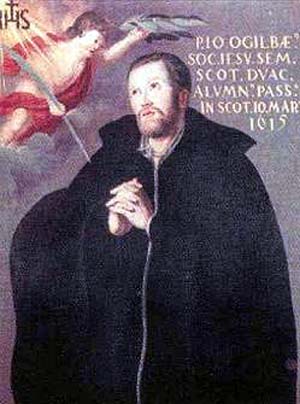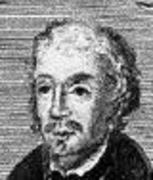
축일:3월10일
성 요한 오질비 순교자
St. John Ogilvie
San Giovanni Ogilvie Martire
1579 at Drum, Keith, Scotland -
hanged 10 March 1615 at Glasgow, Scotland; no relic of his body has survived
Canonized :1976 by Pope Paul VI
The Society of Jesus(Company of Jesus, Jesuits)

그는 가톨릭과 프로테스탄트가 뒤섞인 혼란한 시대에 태어났으나,
가톨릭의 정통성을 인정하게 되자, 순교를 각오하고, 루벵의 스코트 대학에서 개종하니, 그의 나이는 17세였다.
그 후 그는 예수회에 입회하였다.
1610년, 그는 빠리에서 사제로 서품되자, 영국 선교사로 임명되었는데, 이때 가명으로 여행하였다.
그의 선교는 그 당시로 보아 지극히 성공적이었는데,
감옥에 갇힌 가톨릭 신자들을 돌보는 위험까지도 감수하였다.
1614년 여름, 그는 몇사람을 개종시켰는데,
이 사람들 때문에 그는 가톨릭 사제임이 탄로되어 이듬 해에 처형되었다.
(성바오로수도회홈에서)

수면
밤에 깊은 잠을 잘 수 있다는 것은 축복 중의 축복이다.
셰익스피어는 그의 작품에서 잠을 “다 해진 걱정의 옷소매를 꿰매는 것”이라고 묘사했다.
적당한 수면은 심리적인 에너지를 채워 줄 뿐 아니라 우리의 면역 체계도 강화시킨다.
충분한 휴식을 취하지 못하면 우리는 글자 그대로 무너질 수밖에 없다.
잠을 못 자게 하는 것이 오래 전부터 쓰이던 고문 중의 하나라는 것은 별로 놀라운 일이 아니다.
요한 오질비는 스코틀랜드 남작의 아들로 유럽에서 공부하던 중 17살에 가톨릭 신자가 되었다.
그 후 예수회에 입회한 요한 오질비는 사제들의 입국을 금지하는 칙령에도 불구하고
비밀리에 조국인 스코틀랜드로 들어갔다.
그는 선교사로 활동하던 중 정체가 드러나 곧 체포 구금되었고 반역죄로 재판을 받았다.
그는 억지 자백을 강요받으며 8일 동안 잠을 재우지 않는 고문을 당했다.
의사가 세 시간 이상 잠을 재우지 않으면 죽게 된다는 경고를 하고 나서야 고문을 면할 수 있었다.
최근의 연구 조사는 우리들 대부분이 실제로 필요한 수면 시간보다
약 한두 시간 정도 잠을 덜 자고 있다고 밝히고 있다.
잠을 덜 자면 그만큼 더 많은 일을 할 수 있다고 생각하기 쉽지만
사실은 그로 인해 생산성이 떨어지고 사고의 위험성이 커지므로 실제적으로는 큰 도움이 되지 못한다.
피곤하다고 느껴지면 몸과 마음을 쉬는 것이 순리다.
하루에 얼마나 자는가? 나는 내 몸이 필요로 하는 만큼 휴식을 취하겠다.
(까리따스수녀회홈에서)


예수회는 어떤 수도회인가?
1. 예수회의 기원
예수회는 성 이냐시오 로욜라와 그의 ’영신수련’(靈神修練)으로 단련받은 초대회원들로 부터 유래한다.
그들의 시대는 16세기의 대격변기였고 종교개혁의 시대였다.
성 이냐시오가 ’주님안의 벗들’이라고 부른 그의 동료들은
오로지 하느님만을 섬기려는 열망으로 자신들에 대한 하느님의 뜻을 식별하여 찾았다.
하느님의 섭리는 이냐시오 성인을 통해서 복음적 권고를 따르는 삶가운데
새로운 생활양식을 일으켜 하느님 백성의 모임인 교회에 봉사하도록 했다.
그리하여 그들이 공동으로 갖게된 비젼안에서 고유한 예수회의 생활양식이 자라났으며,
결국 예수 그리스도의 거룩한 이름을 가진 성직 수도회가 결성되었다.
예수회는 1540년에 사도좌의 인가를 받아 교회 안에서 탄생하였다.
2. 예수회의 행동양식
예수회의 유일한 목적은 하느님의 은총으로 회원 자신뿐만 아니라
동시에 이웃의 구원과 완덕을 전심전력으로 추구하는데 있다.
더우기 그 모든것에서 ’하느님의 더 큰 영광’ 을 위해 봉사하는 것이다.
이 목적은 예수회의 행동양식을 결정하며, 예수회를 수도적이면서 특히 사도적인 단체로 만든다.
예수회의 사도적 활동은 세계 전역을 대상으로 하고
제한없는 기동성을 요구하며 더 어려운 사명을 기꺼이 받아들이게 한다.
따라서 교회의 필요에 즉각적으로 응해 어디나 가서 활동할 자유를 얻기 위해,
이전의 전통적인 수도생활 양식 안에 있던 여러가지 방해 요소들을 과감히 포기하여
근본적으로 쇄신된 수도생활 양식이 성립되었다.
예수회의 행동양식은 ’영신수련’(靈神修練)을 통해 관상한 그리스도,
즉 가난하고 겸손하신 그리스도를 인격적으로 만나고 무조건적으로 따르는
전적인 자기헌신에서 나오는 영적이며 인간적인 태도이다.
그리스도는 예수회원 모두에게 삶과 일의 원형이 되시며,
또한 각자의 상황안에서 사도적 적응성을 가지고 항상 ’그 이상의 것’을 선택하도록 재촉하신다.
그리스도로 말미암아 예수회원은 세상 안에서 활동하는 관상가가 되며,
그리스도의 대리자인 교황과의 특별한 유대속에서 교회와 함께하는 정신으로 봉사한다.
예수회원은 무상으로 봉사할 마음을 가지며, 기도로써 길러지고
체득된 식별의 감각을 지니고 세상안에서 활동한다.
예수회 전통은 봉사의 질과 자기도야에 있어 엄격함을 유지하여 왔으며,
인간적인 것에 대한 고결한 감각으로 참으로 인간다운 것을 존중한다.
예수회원의 행동양식은 외면상으로는 평범하고 또 그것을 추구하나,
내적으로는 자신의 목적의 탁월한 완성을 위해 노력한다.
3. 오늘날의 예수회원
예수회는 그 시대와 세계 안에서 그리스도를 관상하면서 영감을 받아
거기에서 사도적 활동력을 보존할 통찰을 길어 내었다.
따라서 우리시대 인간들의 염원과 필요를 보되 그리스도의 눈으로 봄으로써,
오늘날의 예수회원들은 스스로의 신원과 사명을 자각한다.
오늘의 예수회원은 이냐시오와 같이 ’예수의 벗’으로 부름받았음을 인식하면서,
’주님 안의 벗들’인 동료들과 더불어 그리스도의 지상 대리자께 결속하여,
이 시대의 가장 심각한 투쟁인 신앙의 봉사와 신앙에 내포된
정의 구현에 헌신하는 사명을 받아 파견된 사람이다.
예수회원은 세가지 서원을 통해 이러한 봉사에 필요한 사도적 자유를 얻어
가난한 이들과 일치하면서 세계의 현실 한 가운데로 뛰어든다.
(예수회 한국지구 성소실홈에서www.sogang.ac.kr/~vocsj)

Saint Ignatious Loyola and Christ -Timothy
*성 이냐시오 데 로욜라 사제 축일:7월31일.게시판586번,1295번.
☞http://home.catholic.or.kr/gnbbs/ncbbs.dll/chinchang
루터는 1517년, 비텐베르크에서 교회의 문에 자기 논문들을 붙였다.
그로부터 17년 후에 이냐시오는 가톨릭 종교 개혁을 위한 너무도 훌륭한 역할을 수행할 수도회를 설립했다.
개신교도들에게 그는 용서할 수 없는 적이었다.
그러나 교회 일치 운동의 근원은 그의 말 속에서 발견된다.
"만일 어떤 이단자들이 박애와 그리스도교적 중용의 본보기를 보여 준다면
그와 똑같은 방법으로 정통파의 진리를 드러내는 데 깊은 배려를 해야만 한다.
그들의 잘못에 대해 어떤 종류의 경멸도 나타내서는 안되며, 혹독한 말도 해서는 안된다."
현대 교회 일치 운동에 공헌한 가장 위대한 사람들 중의 한 사람은 예수회 회원인 베어 추기경이었다.
Dedication to Jesus
Lord Jesus Christ,
take all my freedom, my memory, my understanding, and my will.
All that I have and cherish you have given me.
I surrender it all to be guided by your will.
Your grace and your love and wealth are enough for me. Give me these,
Lord Jesus, and I ask for nothing more. Amen.
"주님,받아 주소서.
내 모든 자유를, 내 기억을, 내 이성을, 내 의지의 모든 것을.
내가 가진 모든 것은 주께서 주신 것입니다.
그것을 주께 돌려드립니다. 청하오니 마음껏 써 주소서.
오로지 주님의 사랑과 은총만을 주소서. 그것으로 저는 충분합니다. 아멘"
-이냐시오 로욜라 성인의 봉헌기도-

♬Take and Receive-Manoling Francisco. SJ
JOHN OGILVIE
Memorial
10 March
Profile
Walter Ogilvie was a Scottish noble who raised his son John in the state religion of Scotland, Calvinism. John converted to Catholicism at age 17 at Louvain, Belgium. Attended several Catholic educational institutions. Joined the Jesuits soon after in 1597, and ordained in Paris in 1610. Sent to work in Rouen, France.
He repeatedly requested assignment to Scotland. "Send only those," wrote the Earl of Angus to the Jesuit General, "who wish for this mission and are strong enough to bear the heat of the day, for they will be in exceeding danger." Wholesale massacres of Catholics had taken place in Scotland, but by this point the hunters concentrated on priests those who attended Mass. The Jesuits were determined to minister to the oppressed Catholic laity. When captured, they were tortured for information, then hanged, drawn, and quartered.
Ogilvie’s request was granted, and he returned to Scotland in November 1613. He worked as an underground missionary in Edinburgh and Glasgow, dodging the Queen’s priest-hunters, disguised as a soldier named Watson. After 11 months in the field, John was betrayed by a phony Catholic, imprisoned, interrogated, then tortured for the names of active Catholics. He suffered, but gave them no information. "Your threats cheer me; I mind them no more than the cackling of geese." Asked if he feared to die he said, "No more than you do to dine."
After three trials, he was convicted of treason for being loyal to the Pope, and denying the king’s supremacy in spiritual matters. He is the Church’s only officially recorded Scottish martyr.
Born
1579 at Drum, Keith, Scotland
Died
hanged 10 March 1615 at Glasgow, Scotland; no relic of his body has survived
Canonized
1976 by Pope Paul VI
San Giovanni Ogilvie Martire
10 marzo
Drum, Keith, Scozia, 1579 - Glasgow, 10 marzo 1615
Emblema: Palma
Giovanni Ogilvie (Ogilby) nacque nel 1579 a Drum in Scozia e di lui non si sa nulla con certezza prima del 1593, anno in cui fu inviato quattordicenne sul Continente a studiare, come molte famiglie facoltose della Gran Bretagna, facevano con i loro figli in quell’epoca.
Si converti al cattolicesimo ed entro nel Collegio scozzese di Douai in Francia; nel 1595 si trasferi a Lovanio in Belgio, dove viene affidato alla guida di padre Cornelio a Lapide. Tre anni dopo nel 1598, lascio Lovanio per proseguire gli studi a Ratisbona, in Germania, nel Collegio dei benedettini scozzesi, poi presso i gesuiti ad Olmutz, dove senti la chiamata di Dio allo stato religioso; ottenne cosi di essere ammesso al noviziato gesuita di Brunn in Moravia, in cui entro il 24 dicembre 1599, aveva vent’anni.
Nel 1607 era a Vienna come docente di sacra eloquenza, compito tenuto per due anni, nel biennio successivo e di nuovo al Olmutz a studiare teologia; viene consacrato sacerdote a Parigi nel 1610 e destinato a Rouen.
Ma il suo desiderio sin dai tempi di Lovanio era quello di ritornare nella sua patria la Scozia, per lavorare nelle missioni cattoliche, bisogna ricordare che in tutta la Gran Bretagna era in corso la persecuzione anticattolica, attuata nel periodo della Riforma anglicana e che in quegli anni era sostenuta dal re Giacomo I Stuart (1566-1625), in Scozia pur essendo della stessa intensita nelle restrizioni e sofferenze, fece comunque pochissime vittime.
Dopo piu di due anni di richieste, rivolte anche al generale gesuita Claudio Acquaviva, fu esaudito e nell’autunno del 1613 pote partire e sbarcare a Leith, un sobborgo di Edimburgo.
Dopo 22 anni di assenza riusci finalmente ad entrare in Scozia con la falsa identita di ‘capitano Watson’. Prese ad operare nell’apostolato missionario ad Edimburgo, ospite di Guglielmo Sinclair, avvocato al Parlamento e fervente cattolico, celebrava clandestinamente le s. Messe frequentatissime, predicando fattivamente ai tanti cattolici che meditavano con interesse la sua parola; si spinse travestito, anche nelle carceri a confortare i molti cattolici prigionieri.
Si reco anche a Londra e Glasgow e fu proprio in questa citta, che venne arrestato il 4 ottobre 1614, su denuncia di Adam Boyd, fatta all’arcivescovo protestante.
Subi per quattro mesi dolorosissime torture e restando sempre strettamente incatenato, tanto da poter compiere pochissimi movimenti, fini davanti ai giudici scozzesi per cinque volte, dal 1614 al 1615; rimangono due resoconti molto particolareggiati dei processi, uno redatto dallo stesso Giovanni Ogilvie e completato dai compagni di prigionia, l’altro e costituito dalla relazione ufficiale inglese fatta scrivere dall’arcivescovo protestante Spottiswood, subito dopo il supplizio del martire.
Il 10 marzo 1615, il sacerdote venne dichiarato reo di lesa maesta dal tribunale di Glasgow e condannato a morte mediante impiccagione; la sentenza venne eseguita nel pomeriggio dello stesso giorno, sulla forca innalzata al centro della citta, nel crocevia detto “Glasgow Cross”.
Contrariamente agli altri condannati, gli fu risparmiato lo scempio dello squartamento dopo morto, non si finisce mai di restare sgomenti davanti alle efferatezze inventate dagli esseri umani contro i suoi stessi simili, lungo il corso dei secoli.
Fu subito sepolto nel cimitero dei condannati e dei suoi resti non se ne seppe piu nulla. La sua causa di beatificazione fu associata nel 1922 a quelle di numerosi martiri inglesi, ma l’episcopato, il clero e i cattolici scozzesi, richiesero un trattamento separato per la gloria della Chiesa di Scozia.
Fu beatificato il 22 novembre 1929 da papa Pio XI e canonizzato da papa Paolo VI il 17 ottobre 1976. Festa liturgica il 10 marzo.
Autore: Antonio Borrelli
John Ogilvie
Gedenktag katholisch: 10. Marz
Name bedeutet: Gott ist gnadig (hebr.)
Priester, Monch, Martyrer
* um 1580 in Drum in Schottland
+ 10. Marz 1615 in Glasgow in Schottland
John wurde als Sohn eines Calvinisten geboren, der Vater war Beamter am Hof von Maria Stuart. Er besuchte hervorragende Schulen, auch in Regensburg, konvertierte mit 17 Jahren zum Katholizismus und trat mit 19 Jahren in den Jesuitenorden ein. Er arbeitete dann in Wien und Graz, bis er 1610 in Paris zum Priester geweiht wurde. Heimlich reiste er nach Schottland zuruck, war als Hauslehrer in Edinburgh tatig und besuchte Katholiken im Gefangnis. 1614 wurde John verraten und auf Anweisung des protestantischen Erzbischofs in Glasgow verhaftet. Er verfasste einen Bericht mit dem Titel "Relatio incarcerationis", "Bericht aus dem Kerker" uber seine Verhaftung und die im Gefangnis erlittenen Foltern, der nach draußen geschmuggelt werden konnte. In einem Gerichtsverfahren wurde er wegen Hochverrats zum Tod verurteilt; er wurde erhangt und gevierteilt.
Kanonisation: Papst Paul VI. sprach John 1976 heilig.
이 게시물을...






